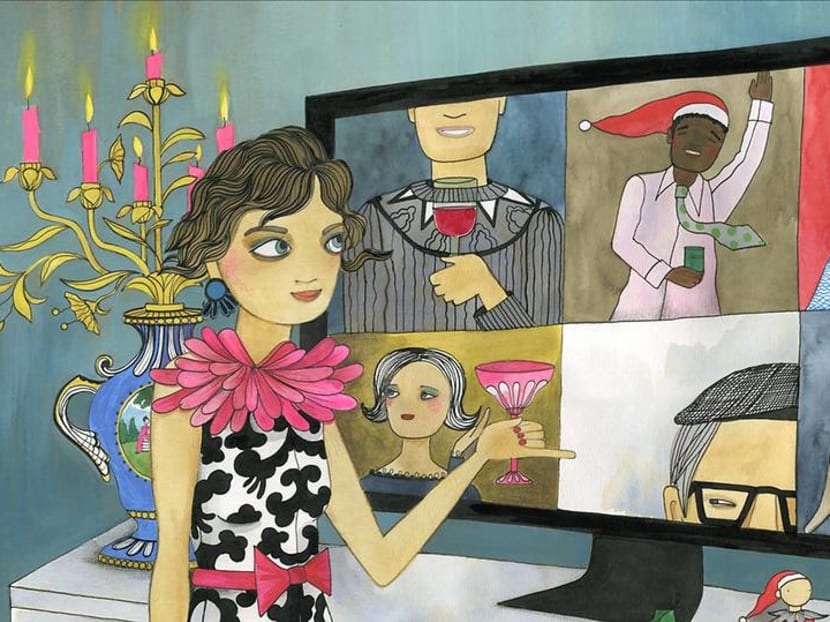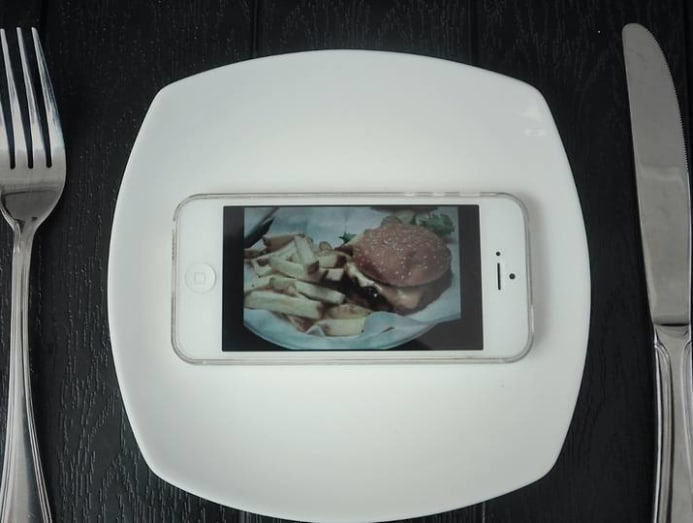What's the holidays without a bit of booze? We bring you Zoom Cocktails 2.0: The Holiday Edition
The virtual happy hour was novel nine months ago, and now it’s back to get us through the holidays. But can we overcome the limits of a virtual social life?

(Art: The New York TImes/Trisha Krauss)
The Zoom cocktail party is back, so throw that shimmery blouse over your sweatpants, pour a glass of spiked eggnog and find a spot with reasonable lighting, because you’re about to spend the holidays with your friends and family on mute.
Yes, I know you’ve been on work video calls for nine months, and didn’t we collectively decide sometime around May that virtual happy hour was over? I certainly thought we were done with this variation of family fun night where we mostly stared at ourselves and wondered if anyone else could tell that our roots were in desperate need of touch up.
Well, we’re not done yet.

The lonely loop of the pandemic has circled back to group video time because the holidays are here and we have to do something. We can’t go the whole season without seeing our grandparents or in-laws or cousins. (Although now that we can put Uncle Bill on mute at Christmas dinner, it’s not all bad, am I right?) Families are sending each other Zoom invites again, with plans to share holiday meals or unwrap presents within view of the computer screen, even if they are weary of virtual connections.
READ: How to still enjoy hearty Christmas meals without worrying about weight gain
“Lots of people are organizing specific things for the winter holidays,” said Victoria Turk, the author of Kill Reply All: A Modern Guide to Online Etiquette, from Social Media to Work to Love. “People are trying to be a bit more creative in how they do that, a bit more organized, which I think is a good thing.”
He sent his sister and parents virtual backgrounds of his dining room, so that when everyone looked at their monitors, they saw the same space.
There’s an art to successfully socialising over video. Those who have made it work say the trick is to actually do something and not just stare into the abyss. Most of us have mastered the virtual backgrounds and the mute button by now, so we can get clever. This is the time for game night, but from afar.
Kevin Pang, the editorial director of digital content at America’s Test Kitchen, hosted a Zoom Thanksgiving with his parents and sister, streaming the video through a television he placed at the far end of the table. He sent his sister and parents virtual backgrounds of his dining room, so that when everyone looked at their monitors, they saw the same space. Each household made their own meal, but they all sat down to eat it at the same time. The evening went so well that they blew past the 30-minute meeting time and ended up chatting for an hour and a half.

“All of a sudden Zoom calls don’t feel like a chore anymore,” said Pang, who is also the founder of the Takeout, a food and pop culture site. “After this Thanksgiving experience, there is nothing I am looking forward to more than the holiday season and having these virtual get-togethers again.”
Really? Are we really all in on Zoom Christmas or Zoom New Year’s? Jeremy Bailenson, the founding director of the Virtual Human Interaction Lab at Stanford University has doubts. He points to the format of video calls as the problem – both overly intimate and extremely distracting. The biggest problem is you’re staring at an intense close-up of your uncle or your mother or your best friend, and who wants that?
READ: Smaller menus, more takeaways this festive season as F&B businesses see ‘high’ eat-at-home demand
Normally, we don’t get that close to another person “unless you’re intimate with someone or you’re in combat with someone,” Dr Bailenson said. “Basically, if you’re about 50 centimeters from another person’s face, you’re about to have a really great encounter or one that’s not about to go so well. Either way it’s fight or flight.”
So rather than feel connected after Zoom, we can feel overwhelmed and fatigued. Add in the other downsides, like how you have to remember to unmute yourself before you speak, or how you constantly stare at your own mirror image, and the entire experience feels surreal. Dr Bailenson has given up on the group video call, preferring playful alternatives like Caribu and Messenger Kids, interactive apps that help his children connect with their grandparents.
The Zoom party can certainly disappoint, especially when we’re all frayed after months of isolation. For Thanksgiving, Erica Dumas, a publicist in Wood-Ridge, NJ, tried to replicate a large holiday gathering with her extended family. Seven households participated. Dumas, her mother and her sister came up with the dishes, sharing the menu with the other households. The three-course meal, with ample sides, included traditional Haitian and American dishes like soup joumou, stuffed turkey, fried red snapper, and Haitian black rice.
In the end, the food was good. The party? Not so much.

Once each household was done toasting and giving thanks, the night became awkward. The individual tables didn’t know whether to talk among themselves or turn their attention back to the screen. Dumas’s daughter, who is 3, kept getting distracted by the video, as did her other young cousins. Eventually, Dumas turned it off and focused on the quiet night at home with her daughter and boyfriend. There was just so much planning for the day that, in a way, was sort of disappointing,” Dumas said. “Like, this is all we get this year?”
READ: When a pandemic meets holiday blues: How to cope with a doubly stressful year-end period
For Christmas, they plan to call each other one household at a time over FaceTime, and post photos of the children opening gifts over WhatsApp.
One piece of Thanksgiving was a success though. After dinner ended, Dumas called her mother in Massachusetts and toasted the night with a glass of Cremas, a Haitian drink. Usually, the two share the creamy beverage in person, so the moment felt like a fleeting connection to what is normally a special day. “It was delicious,” Dumas said. “It was sort of like being home again.”
For Christmas, they plan to call each other one household at a time over FaceTime, and post photos of the children opening gifts over WhatsApp.
Maybe for this to work, we need to check our expectations at the keyboard and accept that none of this is normal. “If you’re trying to emulate a real life get together, you’re probably going to be disappointed,” said Turk, who is also features editor at Wired UK.
Delegate someone to run the event, and include activities. But realise that for some people, the format will simply not resonate. “It’s never going to be everyone’s cup of tea, and I think that’s fine,” she said. “I quite enjoy it.”
It works for Clare Skyles, 41, who lives with her family in Montclair, NJ. Skyles, who owns a graphic-design business with her husband, plans to spend Christmas Eve on FaceTime with her father, stepmother, and probably her stepsister too, in England.
She bought both households matching Fair Isle print pajamas from Hanna Andersson. And they plan to spend the holiday reading stories and playing “Kids Against Maturity,” a game both households now own. “It’s a good game because it’s so ridiculous you don’t have to coordinate pieces,” Skyles said. “Whoever wins, wins.”
It’s not perfect. Skyles’s parents have a spotty internet connection and the calls frequently freeze. “It requires patience,” she said, a skill her 6-year-old son lacks. He’ll often wander off until the connection is restored, but he eventually returns to chat with his grandparents, or just be with them.
“We’ve gotten better at having nothing to say and just kind of checking in with one another,” Skyles said.
And sometimes, it seems, that’s enough.
By Ronda Kaysen © The New York Times



